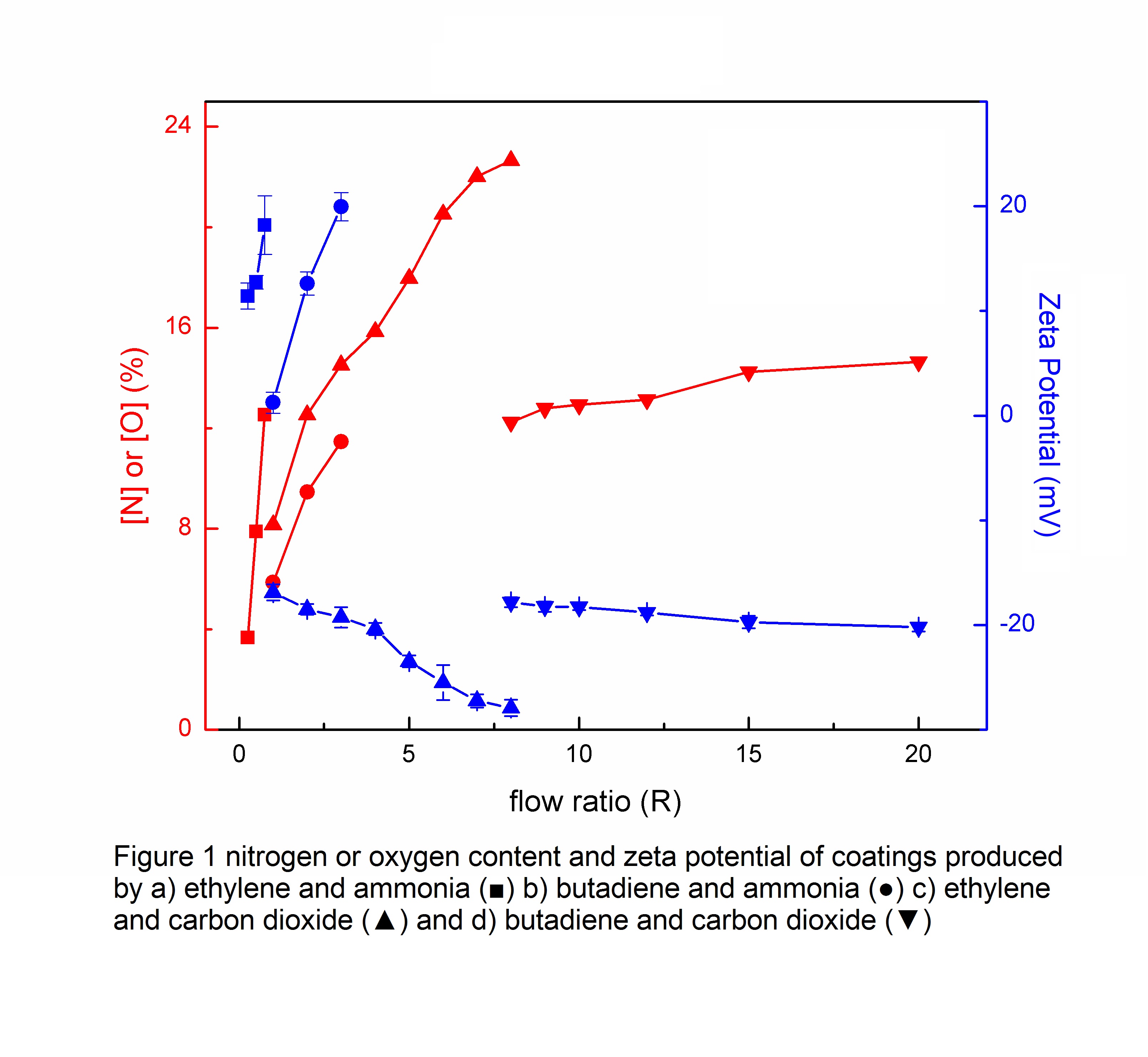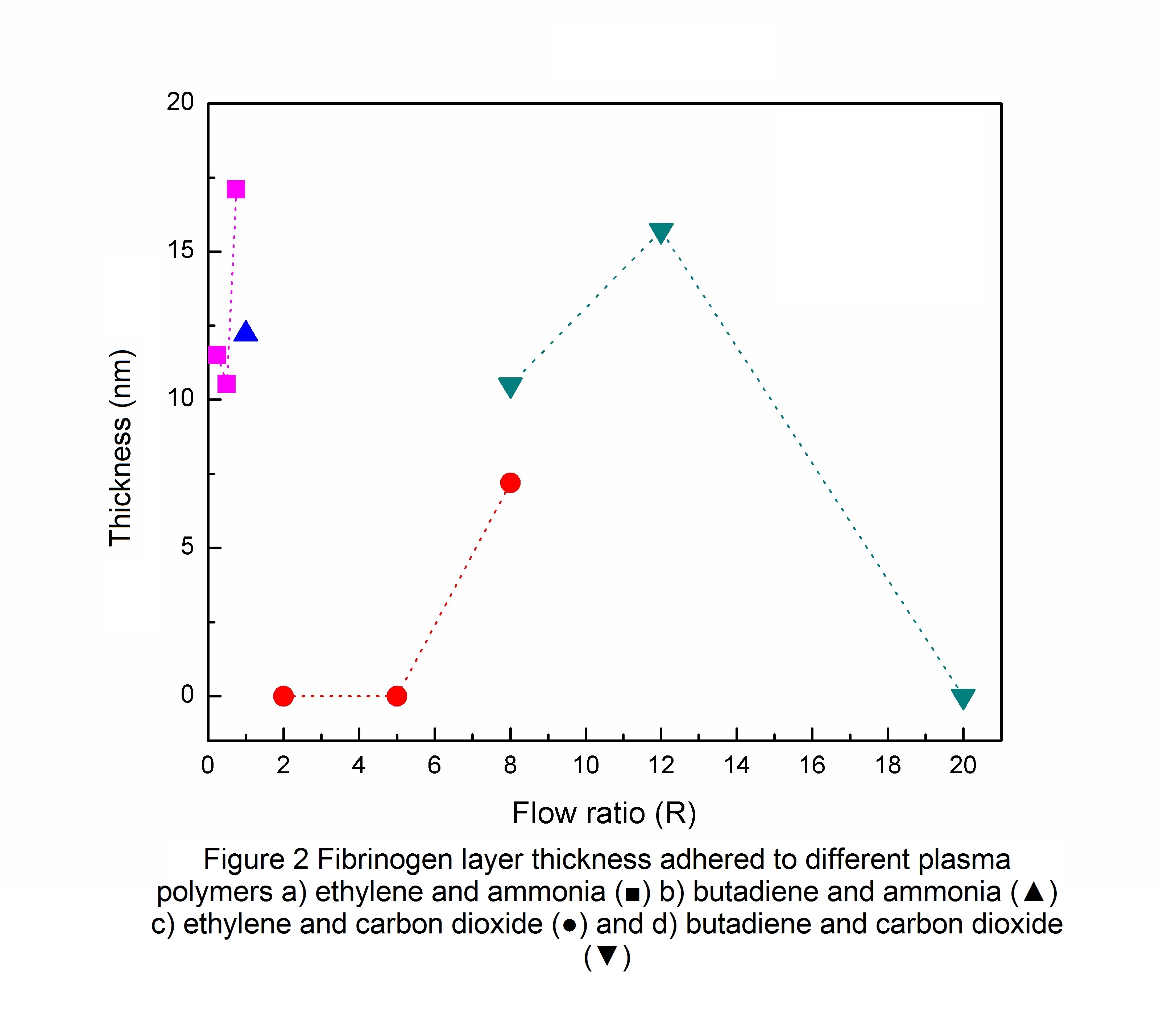Introduction: Under physiological condition, the adhesion of cells to a biomaterial is mediated mainly by presence of a protein layer. The adhesion of proteins to a biomaterial mainly depends on the surface physico-chemical properties; such as functional groups, surface energy, roughness and surface charge[1]. Among others, primary amines and carboxylic acid groups participate in rendering surfaces bioactive through the immobilization of biomolecules; therefore, nitrogen and oxygen based functional groups have been shown to be of high importance for biomedical applications. For instance, it has been previously reported that specific cell lines adhere to the amine rich coatings only if they contained a minimum amount of primary amine content. In this regard, it is possible to obtain adhesion-deterrent to adhesion-promoting surfaces for a specific cell type[2].
In this study, organic films with tunable oxygen/nitrogen functional group content and surface charge were produced by low-pressure plasma co-polymerization of binary gas mixtures of a hydrocarbon (ethylene/butadiene) and a hetroatom containing gas (carbon dioxide/ammonia) for the purpose of selective cell adhesion. Plasma polymerization parameters give direct control over the chemistry of the prepared surface, thus its surface charge can be easily adjusted. This study emphasizes on studying the chemical composition and surface charge of plasma polymers by using a combination of characterization techniques followed by investigation of surface parameters which affect protein adhesion (fibrinogen, fibronectin) with the objective of gaining an understanding of the links between surface characteristics of N and O rich plasma polymer films and cell adhesion.
Materials and Methods: Plasma depositions were performed in a capacitive-coupled radio frequency plasma reactor. In order to produce plasma polymers with different surface characteristics, the gas flow ratio of the heteroatom gas source/hydrocarbon source gas, R, and has been changed between experiments. The coatings were analyzed to determine the chemical composition, evaluated by X-ray photoelectron spectroscopy (XPS), chemical derivatization and infrared reflection-absorption spectroscopy (IRRAS). The surface charge of plasma polymers films deposited in various conditions was evaluated by measuring their zeta-potential using an electro-kinetic analyzer (EKA). The protein adhesion to different plasma polymer coatings was evaluated by surface plasmon resonance (SPR).
Results and Discussion: The results show that the [N] and [-NH2] of nitrogen rich coatings rise nearly linearly with increasing R. The [O] and [-COOH] concentration of oxygen rich coatings at different R values also show an almost linear increasing trend. The nitrogen rich films acquire positive surface charge due to existence of amine groups and in the same fashion, carboxyl groups in oxygen-rich coatings result in negative surface charges at physiological pH. In agreement with XPS results the absolute value of zeta potential increases by increasing the flow ratio in both nitrogen and oxygen rich coatings, due to more abundant amine and carboxylic groups, respectively (Fig 1).

The SPR results showed a surface composition dependent protein adhesion to both nitrogen rich and oxygen rich plasma polymers, Fig 2.

Conclusion: It has been shown that the surface composition of O- and N- rich plasma polymers provide control over the surface charge when immersed in aqueous solutions at physiological pH and promote fibrinogen adhesion.
McGill Engineering Doctoral Award (MEDA); Natural Sciences and Engineering Research Council of Canada (NSERC); Fonds de Recherche du Québec - Nature et Technologies (FRQNT)
References:
[1] K. Webb, V. Hlady, and P. A. Tresco, "Relative importance of surface wettability and charged functional groups on NIH 3T3 fibroblast attachment, spreading, and cytoskeletal organization," Journal of biomedical materials research, vol. 41, p. 422, 1998.
[2] P.-L. Girard-Lauriault, F. Mwale, M. Iordanova, C. Demers, P. Desjardins, and M. R. Wertheimer, "Atmospheric Pressure Deposition of Micropatterned Nitrogen-Rich Plasma-Polymer Films for Tissue Engineering," Plasma Processes and Polymers, vol. 2, pp. 263-270, 2005.